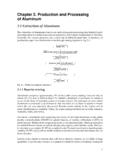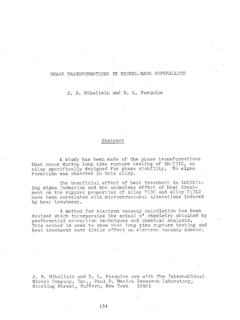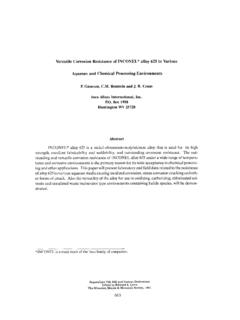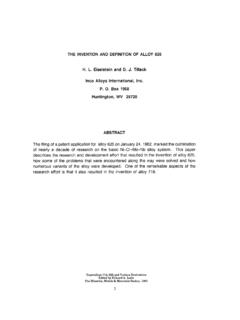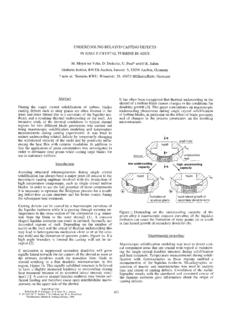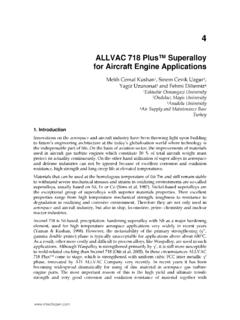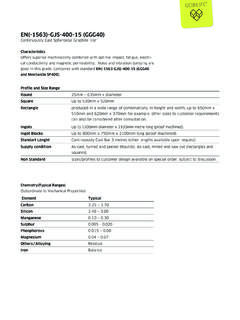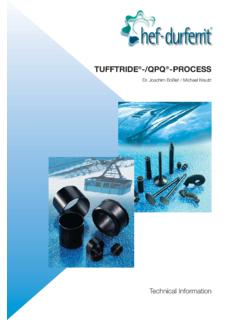Transcription of The Effects of Different Alloying Elements on the Thermal ...
1 THE Effects OF Different Alloying Elements ON THE THERMALEXPANSION COEFFICIENTS, LATTICE CONSTANTS AND MISFIT OFNICKEL-BASED SUPERALLOYS INVESTIGATED BY X-RAY DIFFRACTIONF lorian Pyczak1, Bastian Devrient2, Hael Mughrabi11 Institut f ur Werkstoffwissenschaften , Lehrstuhl I, Universit at Erlangen-N urnberg, Martensstrasse 5, D-91058 Erlangen, Germany2now at: Framatome ANP, Freyeslebenstrasse 1, D-91058 Erlangen, GermanyKeywords: partitioning behaviour, Alloying Elements , lattice constants, Thermal expansionAbstractThe influence of variations of the chemical composition,especially by adding refractory Elements , on the lattice pa-rameter and Thermal expansion coefficients of nickel-basedsuperalloys was investigated. To analyse these Effects in asystematic way, measurements in a series of experimentaland commercial alloys with Different alloy compositionswere performed.
2 The lattice constants of the and phases were measured by X-ray diffraction at tempera-tures between 25 C and 1100 Effects of rhenium additions, but alloy compositionscontaining ruthenium and iridium were also included. Itwas possible to interpret the changes of the lattice pa-rameters of and as Effects of certain Alloying elementsby analysing the local chemical composition of the and phases and the partitioning behaviour of the alloyingelements between the and solution strengtheners like tungsten, molybdenumand rhenium helped to improve the mechanical propertiesof modern nickel-based superalloys [1]. Especially rhe-nium additions resulted in remarkably increased mechan-ical strength [2 4]. To overcome some problems which areassociated with the Alloying of rhenium, especially withrespect to the phase stability of the alloy composition, al-ternative Elements like ruthenium and iridium have alsobeen alloyed in some recently developed nickel-based su-peralloys with the aim to investigate, whether it is possibleto totally or partially substitute rhenium [5, 6].
3 Nevertheless, the most pronounced gains in mechani-cal strength resulted not from modifications of the alloycomposition but from beneficial grain and precipitatestructures [7]. Superalloys which are cast as single crys-tals with a volume fraction between 60 to 70 % of cuboidal particles of about 300 - 500 nm edge length are thematerials of choice for turbine blade applications [8, 9].Unfortunately, the initially cuboidal shape of particleschanges during service at elevated temperatures. A direc-tional coarsening or so called rafting of the particlesis observed which results in elongated rod- or plate-likeshaped particles [10 17]. The orientation of the raftsdepends on the direction of the external load and the signof the lattice misfit between the precipitates and the matrix phase at the deformation temperature. Unfortu-nately, in most relevant cases, in that region of a bladein which the combined action of Thermal and mechanicalloads is most severe (stress above ca.)
4 150 MPa, tempera-ture 950 C, compare [18]), the development of the raftstructure leads to a deterioration of the mechanical prop-erties of the alloy [9,19]. In this respect, it is interesting toinvestigate the Effects of Different Alloying Elements on thedevelopment of the / microstructure. As already men-tioned above, the driving force for rafting is a combinationof external applied stress and the coherency stresses be-tween and phase because of the / lattice a certain Alloying element influences the lattice mis-fit depends on the partitioning behaviour of the elementbetween and phase and on how the lattice constant ofthe phase is influenced by the Alloying element. Elements ,which increase the lattice constant, but divide evenly be-tween and , increase the mean lattice parameter of thealloy but will not influence the lattice mismatch, becausethe lattice constant of both phases will , the latticemisfit and the resulting coherency stresses betweenthe and phase change significantly between roomtemperature and temperatures in the range of the servicetemperature of nickel-based superalloys between 800 Cand 1100 C, due to Different Thermal expansion coeffi-cients of the two phases and [20 24].
5 By using X-raydiffraction, it is possible to measure the lattice constantsof the and phase over a wide temperature range andto obtain lattice misfit values from room temperature totemperatures well above 1000 to the small size of the precipitates and theeven smaller width of the matrix channels a method827 Superalloys 2004 Edited by Green, Pollock, H. Harada,TMS (The Minerals, Metals & Materials Society), Howson, Reed, Schirra, and S, Walstonto determine the local chemical composition with highlateral resolution is needed to measure the partitioningbehaviour of Alloying Elements between and measurements (energydispersivespectroscopy) inthe transmission electron microscope (TEM) can providelocal chemical compositions with the necessary lateral res-olution and were applied frequently to nickel-based super-alloys to supplement other measurement methods, for ex-ample [3, 25, 26].
6 The present work focuses on the investi-gation of Effects of Different Alloying Elements on the latticeparameters of nickel-based superalloys and the changes oflattice constants and lattice misfit at elevated tempera-tures. The high-temperature measurements of the latticemisfits were part of the diploma thesis of one of the au-thors [27].ExperimentalSpecimensThe investigated alloys are a series of experimental al-loys with a directionally solidified grain structure intendedas turbine blade materials for industrial gas turbines [28]and additionally the two commercial alloys CMSX-6 andCMSX-4 as examples of materials used to produce airfoilturbine blades. The chemical composition of the series ofexperimental alloys is based on the alloy composition ofthe commercial alloy IN792DS. The contents of differentalloying Elements like rhenium, ruthenium, iridium, alu-minium and/or tantalum were varied in the experimen-tal alloys to improve the overall properties.
7 The detailednominal composition of all investigated alloys is given intable 1. The nominal chromium level of all experimen-tal alloys was chosen to be , to ensure sufficientcorrosion resistance in stationary gas turbine applications,even when an oxidation or corrosion protection coatingfails during service. But the alloys ExAl 8 and ExAl 10have an actual chromium content of only com-pared with the nominal content of These dif-ferences in the chromium content are important for theinterpretation of some of the following results. The alloysCMSX-6 and CMSX-4 have a lower chromium content,because hot corrosion is normally not so severe in airfoilapplications, due to cleaner fuels and shorter partitioning behaviour of the Different Alloying ele-ments was determined by measuring the local chemicalcomposition of the and phase in a Philips CM200 TEM using an EDS system.
8 All measurements were per-formed in scanning mode using an acceleration voltage of200 kV and a nominal spot size of 5 nm. The orienta-tion of the specimens were chosen to be near [001] by cut-ting a section with the appropriate orientation, which wasground to a thickness of about 70 m and subsequentlyelectrochemically each alloy, measurements in five Different parti-cles and five Different positions in the matrix were results were evaluated in the form of partitioningratioskwhich are defined as the concentration of an alloy-ing element in the phase divided by the concentrationof the element in the matrix:k / =c c (1) Elements with a tendency to enrich in the phase havekfactors greater than one while Elements , which preferentlyenrich in the matrix havekfactors below one. Fromthe five measurements in each alloy a mean partitioningfactorkfor each element in this alloy was diffractionAll X-ray diffraction measurements were performed witha double crystal diffraction setup, illuminating the spec-imens with the copperK 1line.
9 The geometry is basedon a setup proposed by Wilkens and Eckert [29]. Thedistances between monochromator crystal and specimenandspecimenanddetectorarechoseni nsuchaman-ner, that instrumental peak broadening is compensatedfor the diffraction conditions of the (002) diffraction peakof a nickel-based superalloy. The detector is a position-sensitive Braun OED-50 which records an angular spec-trum of about 6 in 2048 channels simultaneously underthe applied diffraction specimens with a surface oriented near the [001] di-rection of the material were mounted on a specimen stagewith the possibility to heat up the specimen from roomtemperature to more than 1100 C. This specimen stage isinserted in a vacuum chamber to minimise the oxidationof the specimen surfaces, which would decrease the inten-sity of the X-ray profiles. Measurements were performedevery 100 C starting from 25 C up to 600 Candthenincreasing the temperature further by 50 C steps untilthe maximum temperature of 1100 C was reached.
10 Bywaiting for a holding time of 10 minutes at each temper-ature, to allow sufficient heat transfer between specimenstage and specimen before recording the X-ray profile, itwas made sure that the specimen had attained the in-tended temperature. All presented data were measuredduring the heating-up of the Different alloys to minimisechanges of the lattice constants due to microstructuralchanges in the specimens during the holding times at ele-vated (002) peak of the nickel-based superalloys is mea-sured, which is a combination of the overlapping (002)peak of the matrix and the corresponding peak of the phase. Due to the slightly Different lattice constants of828 Table 1: Nominal chemical composition of the investigated alloys in actual chromium content is %the and the phase in most nickel-based superalloysthe shape of the combined / peak is asymmetric.

